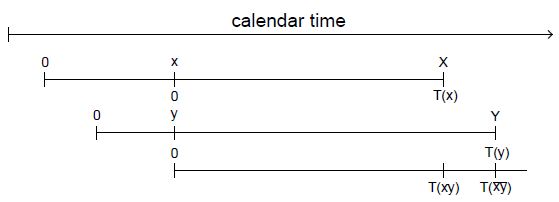We consider two lives who are ages (x) and (y), respectively, at contract initiation. The future remaining lifetimes are (T(x)) and (T(y)) at contract initiation. To aid with interpretation, we think of “(x)” has the “insured’s” and “(y)” as the “spouse’s” age because many joint life contracts are sold to married couples (although the theory clearly applies to many other situations of interest, e.g., an insured with a grandchild).
We are interested in known functions of these future remaining lifetimes (e.g., “(g)”), (g(T(x),T(y))); these functions are known as a status. Here are the two most important examples:
Joint Life Status. In this case, the interest is in (g(T(x),T(y))=min(T(x),T(y))=T(xy)), which is the time until the first of the two lives fails.
Last Survivor Status. In this case, the interest is in (g(T(x),T(y))=max(T(x),T(y))=T(overline{xy})), which is the time until the second of the two lives fails.
